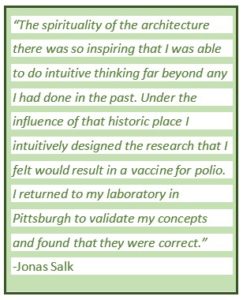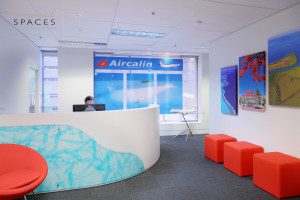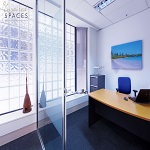What Does The Polio Vaccine And Architecture Have In Common? Well, how many times have you walked into a room and felt like you belonged? How about a space that you felt productive in, one that made you feel creative? Do you know that it is clever interior design that creates this feel? Your built environment influences so many facets of your life. And, it’s only recently that leaders are recognising the importance of a well thought out and designed environment.
 Inspirational environments
Inspirational environments
Jonas Salk, the inventor of the polio vaccine, credits his discovery to a 13th Century Monastery known as the Basilica of San Francesco d’Assisi. He had hit a stalemate in his dark basement laboratory in Pittsburgh. So decided to take a break and retreated to the Monastery in the quiet hills of Assisi, Italy. The Basilica could not have been more different than the lab with its beautiful Romanesque Architecture and Gothic styles. It was only after he spent time roaming through columns and cloistered courtyards that he was able to have new insights into the problem he was trying to solve.
Jonas so strongly believed that architecture influenced the mind that he built the ‘Salk Institute’ to stimulate breakthroughs and creativity. This is where lies the connection between the Polio Vaccine and Architecture.
Clever design helps productivity and creativeness
Researchers are now studying how to design spaces that promote creativity, keep students focused or create relaxation and intimacy.
In 2007, a study demonstrated that the height of a room affected how people processed information. The higher the ceiling, the greater the ability for creative thinking and freer thoughts. Conversely lower ceilings allowed people to focus on details. This is where the use of bulkheads are great in an open-plan space.

Although the office of Aircalin is in the CBD, the use of natural images removes the boxed-in feel
A 2000 study found that if people had views to natural settings, either real or images they were able to concentrate better. It is suggested that urban settings are too stimulating with traffic and crowds. It takes more cognitive effort to deal with them than it does to look at a stream or forest of trees. The natural elements help calm us down and can reduce stress.
What about lighting?
It has long been recognised that correct lighting is vital in fighting fatigue. Researchers have found that using blue light-emitting diodes such as LED’s will keep your staff alert and awake.
However, using more natural light in schools (for example) provides a better learning environment for the students and, along with natural air, is known to help stimulate productivity.
So it seems, if you are struggling to think creatively or are stuck on something, then taking a break and going to an open space with natural light and fresh air might help solve the problem (as it did with Jonas Salk).
Effective design for commercial spaces
When designing for an office or commercial premise it is important the designer understands the culture of the company, work structure and type of work. The company’s mission statement is important and the target market vital if the correct design is to be produced.
 If the designer is not asking questions about spatial organisation, circulation, information transfer, interface and staff interaction you have the wrong person. These connections are vital to understanding the nature of the business and good effective design.
If the designer is not asking questions about spatial organisation, circulation, information transfer, interface and staff interaction you have the wrong person. These connections are vital to understanding the nature of the business and good effective design.
Interior design affects office productivity by influencing access to people and resources, comfort, privacy and flexibility.
The space is your brand, your community and your organisation. To ensure your corporate image matches your perceived image, a well-designed space is a necessity.
Click here to view a video testimonial from Premium Strata about their office design by Inspired Spaces.





Leave A Comment Or Ask A Question